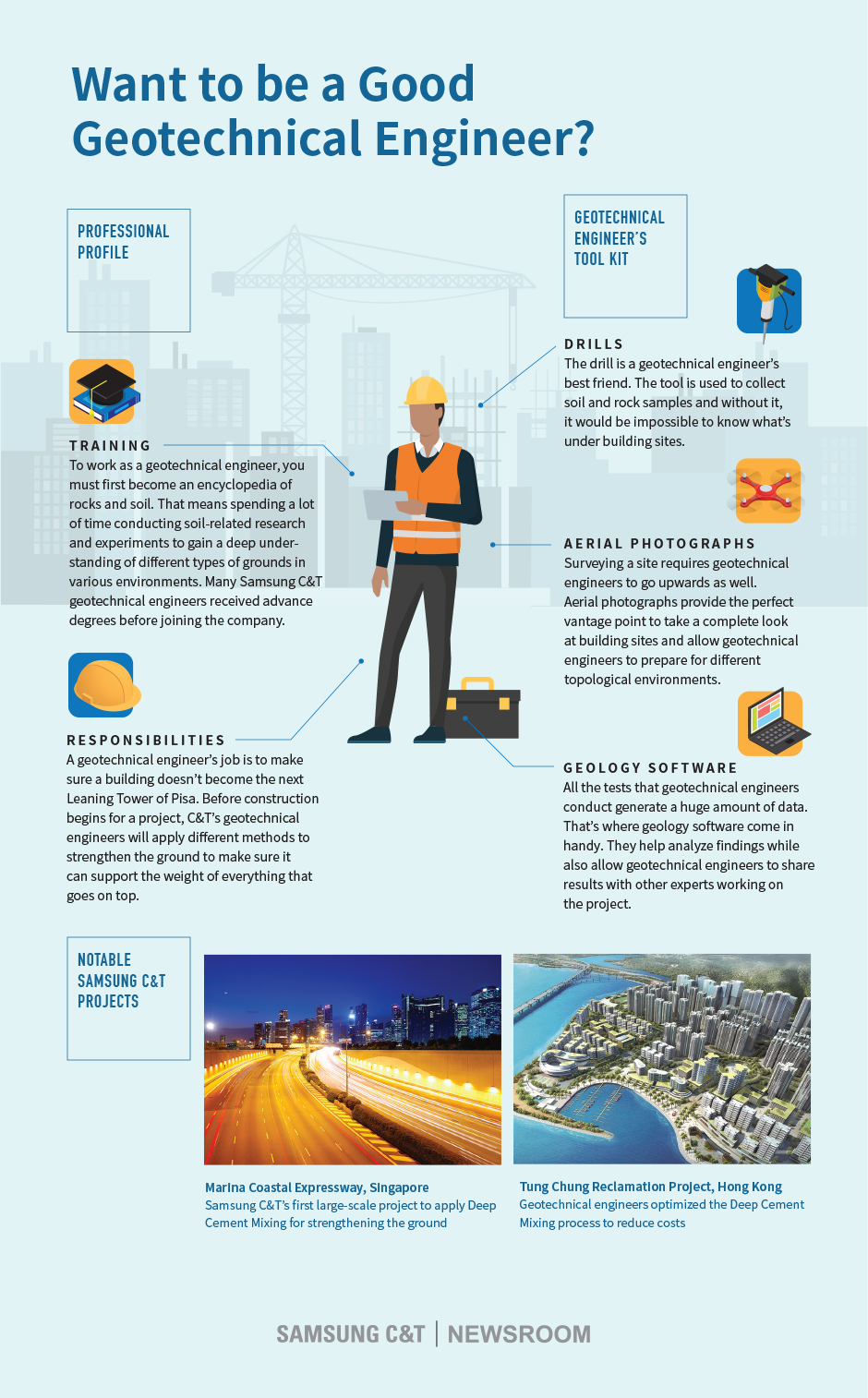5 Easy Facts About Geotheta Described
5 Easy Facts About Geotheta Described
Blog Article
Indicators on Geotheta You Need To Know
Table of ContentsGeotheta Can Be Fun For EveryoneGetting The Geotheta To WorkThe 45-Second Trick For GeothetaRumored Buzz on GeothetaExamine This Report on Geotheta

They carry out website examinations, accumulate samples, perform lab examinations, and evaluate data to examine the suitability of the ground for building and construction projects - Geo Tech Engineering. Based on their findings, geotechnical engineers give suggestions for foundation layout, incline stability, maintaining frameworks, and reduction of geotechnical threats. They team up with other professionals, such as engineers, architectural designers, and construction groups, to guarantee that geotechnical factors to consider are integrated into the general job design and implementation
By examining the actions and buildings of dirt and rock, they can recognize possible geotechnical threats such as landslides, dirt negotiation, or incline instability. Their know-how assists stop failures or accidents that could endanger lives and residential property. Right here are some in-depth obligations and obligations of a geotechnical engineer: Site Investigation: Geotechnical engineers conduct site investigations to collect data on subsurface conditions.
They translate the data to understand the buildings and habits of the dirt and rock, including their toughness, leaks in the structure, compaction features, and groundwater problems. Geotechnical Evaluation and Design: Geotechnical designers analyze the information accumulated throughout website examinations to assess the security and viability of the website for building and construction tasks. They perform geotechnical computations and modeling to evaluate elements such as bearing capability, settlement, slope stability, lateral earth stress, and groundwater flow.
Geotheta Can Be Fun For Anyone
Foundation Style: Geotechnical designers play a vital duty in making foundations that can securely support the intended structure. They examine the soil problems and load needs to establish the proper foundation kind, such as shallow structures (e.g., footings), deep structures (e.g (https://geotheta.start.page)., stacks), or specialized methods like soil enhancement. They take into consideration variables such as settlement limits, birthing ability, and soil-structure communication to create optimal foundation layouts
They review construction strategies, display site tasks, and perform area assessments to confirm that the design recommendations are complied with. If unanticipated geotechnical issues develop, they evaluate the situation and provide referrals for removal or adjustments to the advice style. Danger Assessment and Reduction: Geotechnical engineers examine geotechnical dangers and risks associated with the project website, such as landslides, liquefaction, or dirt erosion.

Partnership and Communication: Geotechnical designers work closely with various other professionals involved in a task, such as designers, architectural engineers, and construction teams. Reliable interaction and partnership are necessary to incorporate geotechnical considerations right into the overall task layout and building and construction process. Geotechnical engineers supply technical know-how, answer questions, and make certain that geotechnical requirements are fulfilled.
How Geotheta can Save You Time, Stress, and Money.
Right here are some sorts of geotechnical designers: Structure Engineer: Structure designers specialize in creating and examining structures for frameworks. They examine the dirt problems, load demands, and website characteristics to determine the most suitable structure kind and layout, such as shallow foundations, deep foundations, or specialized techniques like stack structures.
They evaluate the elements affecting incline stability, such as dirt residential properties, groundwater problems, and incline geometry, and create methods to stop slope failings and reduce dangers. Quake Designer: Quake designers concentrate on assessing and making structures to withstand seismic forces. They analyze the seismic danger of a website, assess dirt liquefaction capacity, and establish seismic layout criteria to guarantee the safety and resilience of structures throughout quakes.
They do field testing, collect samples, and evaluate the collected information to identify the soil buildings, geologic developments, and groundwater problems at a site. Geotechnical Instrumentation Designer: Geotechnical instrumentation designers concentrate on tracking and determining the behavior of dirt, rock, and structures. They install and keep instrumentation systems that keep track of variables such as soil settlement, groundwater levels, incline activities, and architectural displacements to assess efficiency and provide very early warnings of prospective issues.
Not known Incorrect Statements About Geotheta
They perform tests such as triaxial examinations, consolidation tests, direct shear tests, and leaks in the structure tests to collect information for geotechnical analysis and style. Geosynthetics Engineer: Geosynthetics engineers concentrate on the style and application of geosynthetic products, such as geotextiles, geogrids, and geomembranes. They use these materials to enhance soil stability, enhance slopes, give drain solutions, and control erosion.
They have a tendency to be investigatory people, which means they're intellectual, introspective, and investigative. They are interested, methodical, rational, logical, and sensible. Some of them are likewise social, indicating they're kind, generous, cooperative, patient, caring, practical, compassionate, sensible, and pleasant - Tailings Engineer.
In the workplace atmosphere, geotechnical designers use specialized software program tools to do computations, create designs, and examine data. They prepare records, testimonial task specs, interact with clients and employee, and coordinate job tasks. The office setup offers a helpful setting for research, evaluation, and cooperation with various other professionals associated with the job.
3 Easy Facts About Geotheta Explained
They frequently go to job sites to perform site examinations, evaluate geotechnical problems, and gather information for analysis. These gos to involve traveling to various locations, in some cases in remote or difficult surfaces. Geotechnical designers might perform soil tasting, conduct tests, and screen construction tasks to ensure that the geotechnical elements of the task are being executed appropriately.
Geotechnical engineers also work in specialized geotechnical labs. Geotechnical lab designers work thoroughly in these settings, handling testing equipment, operating instruments, and tape-recording information.
Report this page